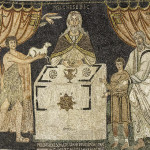We run our website the way we wished the whole internet worked: we provide high quality original content with no ads. We are funded solely by your direct support. Please consider supporting this project.

The All-Too-Common Montage God
How do you picture God? It’s impossible to exaggerate the importance of a believer’s mental picture of God. The intensity of your love for God will never outrun the beauty of the God you envision in your mind. So our mental picture of God completely determines the quality of our relationship with God.
In fact, there is now mounting neurological evidence that a person’s mental picture of God significantly impacts the quality of their life, for better or for worse. For example, it is a neurological fact that people who have a loving mental picture of God tend to have a greater capacity to think objectively about controversial matters and to make rational decisions than people who have a scary mental picture of God. There is a great book on this entitled The God-Shaped Brain: How Changing Your View of God Transforms Your Life by T. R. Jennings.
This can prove problematic if people adopt the common way of reading the Bible where everything in the Bible should be given equal weight. All must carry the same level of divine authority. With this “flat view of the Bible,” Jesus is more or less placed on the same level as all other portraits of God. As a result, people end up having a montage conception of God. That is, part of the God these Christians envision is Christ-like, but other parts are vengeful and jealous and capable of doing horrible things like commanding genocide and killing families by smashing together parents and children.
No wonder so many people have trouble feeling passionate love for God.
I have become convinced that this approach is fundamentally, and tragically, misguided. While I continue to affirm that the whole Bible is “God-breathed,” I am now persuaded that we should base our mental picture of God solely on Jesus Christ. Other biblical portraits of God may nuance our Christ-centered picture, but only to the degree that they cohere with what we learn about God in Christ.
I make this claim because this is exactly what the Bible claims. In Hebrews, we read:
In the past God spoke to our ancestors through the prophets at many times and in various ways, but in these last days he has spoken to us by his Son, whom he appointed heir of all things, and through whom also he made the universe. The Son is the radiance of God’s glory and the exact representation of his being, sustaining all things by his powerful word (Heb 1:1-3)
The Son is the one and only exact representation of God’s very being, or essence (hypostasis). This means that Jesus is the perfect revelation of everything that makes God God. C. S. Lewis once said; “Jesus is what the Father has to say to us.” Jesus is not part of what the Father has to say or even the main thing the Father has to say. As the one and only Word of God (Jn 1:1), Jesus is the total content of the Father’s revelation to us. For this reason, Jesus must be our criterion to access the degree to which previous prophets caught genuine glimpses of truth. Only then will you overcome the debilitating montage picture that will hinder your love and passion for God, and for life.
—Adapted from Cross Vision, pages 18-21
Category: General
Tags: Cross Vision, Cruciform Theology
Topics: Attributes and Character, Christus Victor view of Atonement
Related Reading

What’s the Purpose of the Old Testament Law?
Whereas the old covenant was rooted in the law, the new covenant is rooted in simple faith, such as Abraham had. Whereas the old covenant was forged with one particular nation, the new covenant is available to all who are willing to accept it, regardless of their ethnicity and nationality. Whereas forgiveness of sins within…

The Cruciform Center Part 1: How Matthew, Mark and Luke Reveal a Cruciform God
In the previous series of posts I’ve argued that a merely “Christocentric” approach to God is too general, as can be shown by the widely different conceptions of God people arrive at, despite their claim to be “Christocentric.” The confession that Jesus reveals what God is like is simply too abstract, for it leaves too…

How To Talk about Theology
Social media is full of theological debate. Theological arguments that formerly took months or even years to get in print, now only takes the time to write a post or 140 characters and click “publish.” Social media is great in that it makes space for all of our voices. However, it also seems to elevate…

Where Psychology and Theology Meet
Guest post by Ty Gibson The biblical narrative reveals that God bears our guilt—not merely in the penal sense that Reformed theology asserts—but in the sense that He bears our misconceptions of His character as we project our sins upon Him. To the degree that fallen human beings find it psychologically impossible to bear the…

Are You Fully Alive? Here’s the Key
Image by rashdada via flickr. The cross reveals the full truth about us. This truth reconnects us with our true source of life, which in turn heals our idol addictions. This dimension of the cross is frankly so breathtakingly beautiful that, so far as I can tell, very few followers of Jesus have ever really grasped it.…

The Entire Old Testament is About Jesus
Jesus himself taught that he carried more authority than any prophet that predated him. Though Jesus regarded John as the greatest prophet up to himself (Matt 11:11), he claimed his own “testimony” was “weightier (megas) than that of John” (Jn. 5:36). Jesus certainly wasn’t denying John or any previous true prophet was divinely inspired. But…
